In this article:
The sciatic nerve is the widest and longest nerve in the body. It begins near the spine in the lower back, runs deep through each buttock, and travels down along the back of each leg.

A shooting pain often so severe, it makes standing up seem like an impossible task, sciatic nerve pain can be an excruciating experience. Ironically, it hurts more when one is sitting down, making this painful ordeal all the more unbearable.
Yoga for Sciatic Nerve Pain
Here are a few yoga poses that can reduce sciatic nerve pain in less than 15 minutes.
Note: Please consult your doctor before performing these yoga exercises.
1. Locust pose (Shalabhasana)
This yoga exercise strengthens your lower back and promotes blood circulation to your lower half of the body. (1)
A preliminary study published in the International Journal of Yoga found that patients suffering from classical symptoms of sciatica showed significant improvement both with Snehan along with asanas (Bhujangasana and Salabhasana) and with asanas only. (2)
Blood circulation in the lower back and the areas below is often compromised due to the pressure that builds up for a number of reasons, resulting in sciatic nerve pain. Better circulation promotes healing and provides pain relief.
How to do:
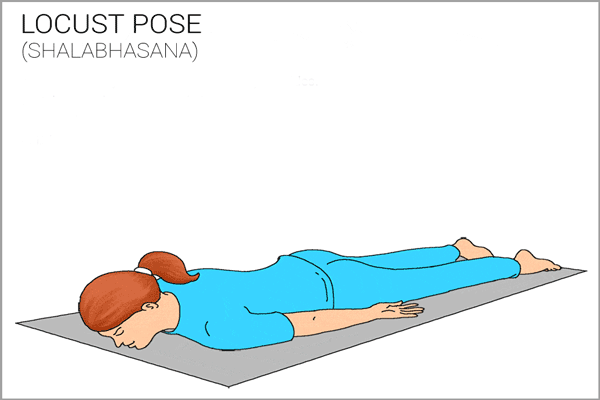
- Lie face down and place your arms at your sides with your palms outwards. Your toes should point downward, and the feet should be hip-distance apart.
- Make sure your chin touches the ground, your neck is elongated, and your pubic bone is pressing down.
- Take a deep breath and raise your legs, arms, and chest simultaneously. Your knees should be lifted off the ground, your shoulders should come close together, and your neck should be straight, chin gently tucking in.
- Once you’ve lifted yourself up, exhale and stay in that position for 5 to 8 seconds. Stretch your back gently.
- Next, maintaining that position, inhale and spread your legs apart, and then exhale and bring them back in. Repeat this exercise 5 times. This is an addition to the traditional locust pose, which is especially effective in reducing sciatic nerve pain.
- Gently bring your body back down to the floor, fold your hands under your forehead, and rest, face down, for 1 minute. You can bend the knees and create a windshield wiper action to relieve the back.
- Repeat this exercise five times.
Beginner’s tip
A great way to introduce your body into this asana (posture) is by doing alternating Shalabhasana.
In the alternating Shalabhasana, you could lift the opposite arm and leg at the same time as the others stay grounded and then you would switch to the other side. This is a great way to start building the foundation for full Shalabhasana.
2. Cobra pose (Bhujangasana)
This yoga exercise strengthens your spine and lower back, providing relief from pain due to a slipped disc – one of the major causes of sciatic nerve pain. (1)(2)
How to do:
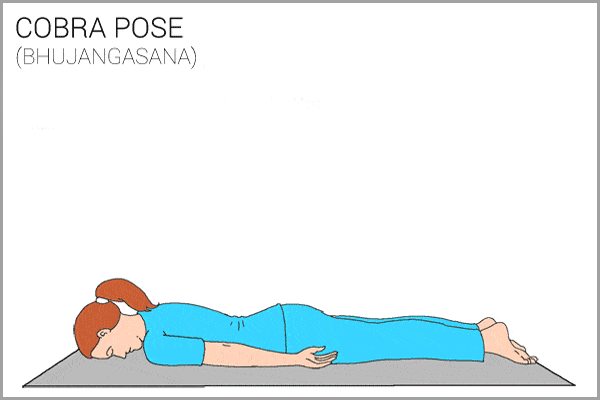
- Lie on your stomach with your legs stretched out and place your palms on the ground underneath your shoulders. Your elbows should be folded upward.
- Press your thighs, navel, and toes into the ground.
- Slowly raise your upper body (head, chest, and stomach) with the support of your arms, while breathing deeply. Bring your shoulder blades close together.
- Maintain this position for 15 to 30 seconds, and then lower your upper body back to the ground and put your hands beside you.
- Rest for a minute before repeating the exercise 5 to 10 times.
Beginner’s tip
Do not overstretch your back. Be gentle.
3. Bridge pose (Setu Bandhasana)
This is an incredibly effective yoga pose for gently strengthening the lower back and major buttock muscles, while stretching the abdominals and chest. Doing so improves flexibility and allows movement in the areas where pain is made worse by constriction and inactivity. (1)
It also improves blood circulation, which is critical to the proper functioning and recovery of any organ of the body.
How to do:

- Lie down on your back, with your knees bent and your feet firmly planted on the floor.
- Draw in your heels close to your buttocks and place your arms, palms down, at your sides.
- Press your feet down, focus on pressing the heels into the floor, and take a deep breath and gently lift your hips off the ground. Consciously push your tailbone down toward your heels. Your shoulders, neck, and head should stay on the floor, your lower back should be elongated, and your inner thighs should be hugging in towards each other.
- Maintain this position for 10 to 15 seconds, exhale, and come back down.
- Repeat this exercise 5 to 10 times.
Beginner’s tip
You can place a yoga block in between your inner thighs to encourage your inner thighs to stay engaged so the lower back stays protected.
4. Reclining big toe pose (Supta Padangusthasana)
This basic hamstring stretch can be therapeutic for those suffering from sciatica pain. It opens up the buttock and alleviates back pain. It also stretches the legs, especially the calves, and promotes circulation throughout the area below the torso. (3)
How to do:
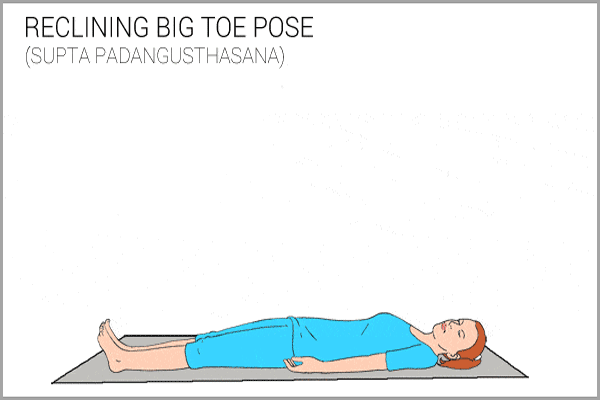
- Lie flat on your back, bend your left knee, and bring it in toward your chest.
- Grab a yoga strap or a belt, secure it around the ball of your foot, and lift your left leg toward the ceiling.
- Stretch your leg, keeping your foot open and flexed and your buttocks pressed to the ground. Allow the bottom-right leg to be extended and foot flexed.
- Breathe deeply and maintain this position for 10 seconds.
- Lower your left knee back toward your chest before placing your leg back on the ground.
- Repeat the exercise with the right leg. Alternate between the legs 5 to 10 times.
Beginner’s tip
If it feels uncomfortable for your back to have the bottom leg extended, you can bend the knee and place the sole of your foot on the ground.
5. Spinal twisting pose (Ardha Matsyendrasana)
By flexing the lower back and hips, this exercise relaxes these areas, releases tension and pain in the back, and promotes circulation. (4)
How to do:
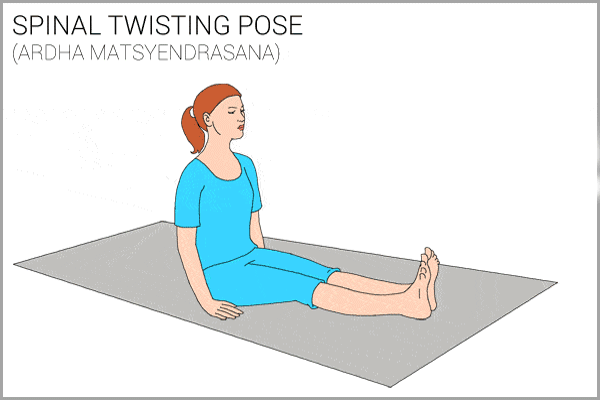
- Sit on a mat with your arms by your sides and your legs stretched forward.
- Bend your right knee, and position your right foot outside of your left thigh.
- Turn your upper body to the right, place your right hand behind your back, and take deep breaths.
- Maintain this position for 30 to 60 seconds, reverse the legs, and repeat the exercise.
Beginner’s tip
Sit on a blanket for comfort and support, and discard it as you get better.
Additional Effective Poses
These two additional poses can also help provide relief from sciatic nerve pain.
1. Staff pose (Dandasana)
This is a basic seated pose. It will stretch your legs, flex your lower back, promote blood circulation in the aching areas, and release pressure from the sciatic nerve and give it room to breathe.
How to do:
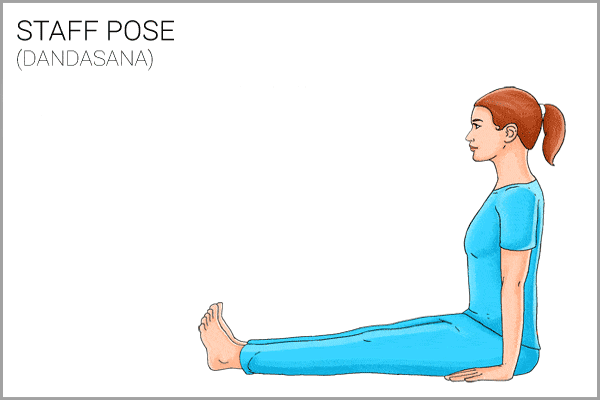
- Sit on a mat with your legs outstretched in front of you and your hands at your sides with your palms touching the floor.
- Stretch your legs by flexing your feet, toes up toward the sky.
- Lift the crown of your head toward the sky and stretch your spine, lengthening it over the legs.
- Take deep breaths, maintaining this position for 15 to 30 seconds.
- Relax, and repeat this exercise 5 to 10 times.
Beginner’s tip
Roll up a blanket, or use any other form of padding, and place it under your buttocks for support. If you are having back pain, have a gentle bend in the knees to relieve any pressure in the back.
2. Pigeon pose (Eka Pada Rajakapotasana)
Sciatic nerve pain often occurs when a muscle in the buttocks called the piriformis exerts pressure on the sciatic nerve, irritating it and pushing it against the tendons located beneath it. This results in a shooting leg and buttock pain.
The pigeon pose is an excellent pose that stretches the piriformis and relieves the pressure on the sciatic nerve.
How to do:
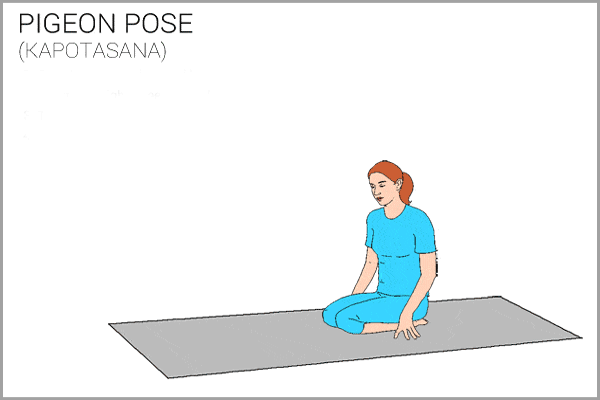
- With your palms flat on the ground, fingers facing forward, and your knees bent on the ground with your hips above your knees, arrive in a tabletop position.
- Starting with your right leg, bring your right knee forward so it is placed behind your right wrist and your right foot is in front of your left wrist. Your shin should be at a 45-degree angle at this point.
- Slide your left leg back, and stretch your torso forward.
- Maintain this position for 5 seconds, inhale, and stretch your hands out in front of you, bringing your forehead toward the ground in a resting position.
- Take deep breaths and maintain this position for 15 to 30 seconds. Make sure you are consciously pushing your left thigh toward the ground and pushing your stomach slightly in for balance.
- Lift your head up, pull your hands back, tuck your left toes in, and pull your right leg back.
- Repeat these steps with your left leg.
- Repeat this exercise 5 to 10 times, alternating between your right and left legs.
Beginner’s tip
Roll up a blanket and place it below your buttocks and upper thigh of the leg in front with the bent knee. This will prop your body up, maintain balance, and prevent your body from sliding to one side (as what often happens) during this pose.
Causes of Sciatic Nerve Pain
Any condition that puts pressure on the lower back will result in sciatic nerve pain, also known as sciatica.
Common causes include the following:
- A herniated or slip disc is most commonly responsible for sciatica. These jelly-filled discs form a soft cushion of tissue between the bones in your spine and tend to break down and leak out their fluid content with age. Sometimes, a disc may protrude out of its place due to spinal injury and trauma or from years of bending or sitting, thereby exerting greater pressure on the adjoining nerves in the lower back.
- Spinal stenosis is the constriction of that part of your spine where the nerves pass through, which may cause sciatic nerve pain.
- Spondylolisthesis refers to the condition when one of the vertebrae slips out of position overlapping another.
- Piriformis syndrome occurs when the piriformis muscle in the buttocks spasms or tightens, thereby putting pressure on the adjoining sciatic nerve.
- Bone spurs, or bone overgrowths, may develop on your vertebrae.
- A back or pelvic injury may also cause sciatica.
Symptoms of Sciatica
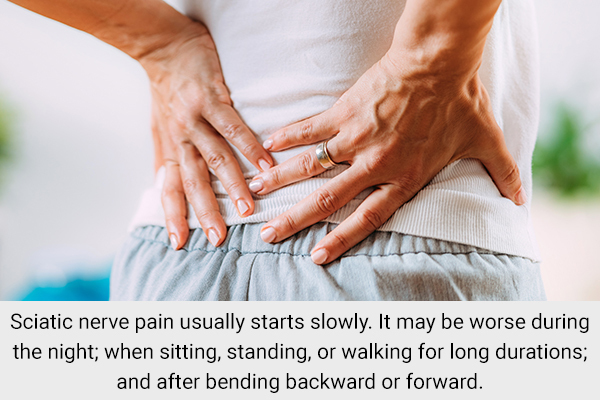
Although the symptoms of sciatica can vary, they most commonly occur on one side of the lower back and extend to the rear and legs and often down to the feet.
Some people report a searing pain in one area of the leg or rear while feeling numb in the other regions. Often, the aching leg may feel cold and weak.
Other symptoms may include:
- Weakness in the lower back or leg
- Numb thighs
- Burning or tingling sensations in the legs, rear, and feet
- Loss of bladder or bowel control
Some people suffer from sciatic nerve pain frequently, whereas others do not. However, if left untreated, symptoms can get worse with time.
Sciatic nerve pain usually starts slowly. It may be worse during the night; when sitting, standing, or walking for long durations; and after bending backward or forward.
Conventional Treatments for and Management of Sciatica
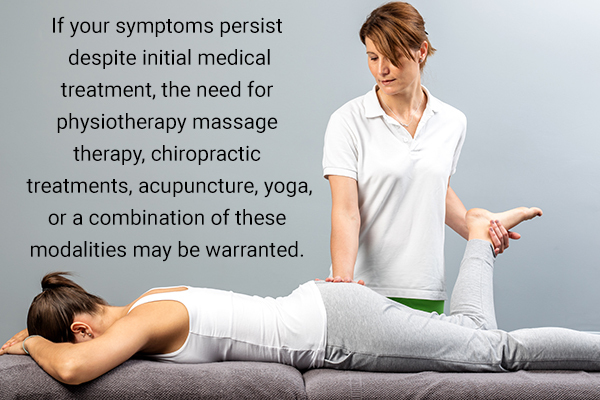
Most cases of sciatica resolve on their own, as herniated spinal discs usually heal themselves with time. Nonetheless, the preliminary treatment for this condition mostly centers on medicines and exercises to provide relief.
The standard medicines for alleviating sciatica include the following:
- The doctor will start off by prescribing a short course of oral NSAIDs for temporary pain relief.
- If the oral NSAIDs fail to provide sufficient relief, a course of oral corticosteroids may be prescribed.
- Stronger medicines such as opioid and nonopioid analgesics as well as muscle relaxants may be used to address severe pain.
- Anticonvulsants are often recommended for neurogenic pain.
- If your symptoms persist despite initial medicinal treatment, the need for physiotherapy massage therapy, chiropractic treatments, acupuncture, yoga, or a combination of these modalities may be warranted.
- Aggressive treatment for sciatica involves the use of epidural injections of medicines such as steroids.
- The doctor may have to resort to surgical intervention if all else fails, to correct any structural abnormalities such as disc herniation, epidural hematoma, epidural abscess, or tumor.
Lifestyle modifications for sciatica management
The use of medicines to treat sciatica is best when it is combined with other lifestyle modifications:
1. Use hot and cold compresses
Apply hot or cold packs for 10 to 15 minutes respectively, every 2 to 3 hours. Although there is no scientific legitimacy accorded to these therapies, they carry considerable anecdotal evidence.
A lot of patients with sciatica have registered considerable comfort and decreased inflammation through the use of compresses, especially when used in conjunction with other treatment options.
Heat therapy is usually recommended before you start an activity such as running or before leaving any sedentary position, to stimulate a healthy amount of blood flow to the area of application. Cold packs, on the other hand, are applied to bring down the inflammation that may result after the activity.
2. Exercise regularly

Sciatica sufferers are advised to maintain a comfortable degree of physical activity, which involves stretching and core-strengthening exercises to work out the abdominal and back muscles.
These customized exercises not only increase the muscle support for your back but also gently flex and stretch the tightened muscles, lumbar spine, and hamstrings that are often the source of your pain.
Resting may seem like the obvious solution, but too much rest can adversely affect the rest of your body and amplify your discomfort in the long run. At the same time, you must avoid any rigorous activity that may end up aggravating your condition.
ALSO READ: Pain Relieving Exercises and Treatment Options for Sciatica
3. Avoid straining yourself
Refrain from sitting or standing for prolonged periods, as doing so may decondition or weaken your back muscles and spinal structures, making them more prone to strain or injury.
If you must stand, try to take the load off from one foot from time to time by resting it on a stool or a box.
4. Correct your posture
Maintaining an upright posture at all times will help decompress the nerves around your spine. Once the pressure on the sciatic nerve is released such that it has enough room to breathe, the pain and discomfort will gradually dissipate.
Use proper ergonomic chairs that keep your back well supported. You can even place a lumbar roll, a contoured cushion, or a rolled towel in the small of your back for adequate lower back support.
5. Safe lifting
As a general rule, it is best for patients with sciatica to avoid any activity that requires muscular force, such as pushing or lifting a heavy object. However, if you must engage in some heavy lifting, the least you can do is use appropriate ergonomics to minimize the strain on your back.
Bed Rest May Not Be Helpful for Sciatica
Exercise fares better in alleviating sciatic nerve pain than complete bed rest. While this approach may go against your normative understanding of pain relief, it carries considerable medical legitimacy. Patients with sciatica are usually advised to rest for a couple of days after a flare-up and gradually get back to their routine thereafter.
The lack of exercise and movement for too long can end up exacerbating the condition by deconditioning your muscles and spinal structures. If your muscles and spine remain out of action for prolonged periods, they become more prone to strain and injury.
Some degree of regular movement promotes the exchange of nutrients and fluids within the spinal discs to keep them healthy and prevent pressure on the sciatic nerve
To retain some flexibility, you must engage in a bit of gentle exercise, unless your doctor specifically advises you against it. For instance, break your lying down sessions with short strolls, gradually increasing your walking distance according to your comfort level.
Walking is relatively a low-impact exercise that releases endorphins into your system and reduces the inflammation around your sciatic nerve roots. You can diversify your exercise routine by doing a bit of yoga and swimming, both of which are not weight-bearing exercises that help improve flexibility and core strength without unduly stressing your back.
Final Word
While there are many medical treatments and therapies for lower back and sciatic nerve pain, many strength and conditioning specialists swear by the beneficial effects of any exercise that involves stretching in reducing sciatic nerve and lower back pain. (5)
One highly effective, specialized, and advanced stretching technique for sciatic nerve pain is yoga.
According to a 2015 study published in the International Journal of Yoga, the practice of yoga was found to decrease pain and increase functional ability in patients with spinal pain. That said, the therapeutic weight and value of yoga for sciatica relief need to be further investigated by more evidence-based researches conducted on a large scale with longer-term follow-up. (3)
- Was this article helpful?
- YES, THANKS!NOT REALLY


